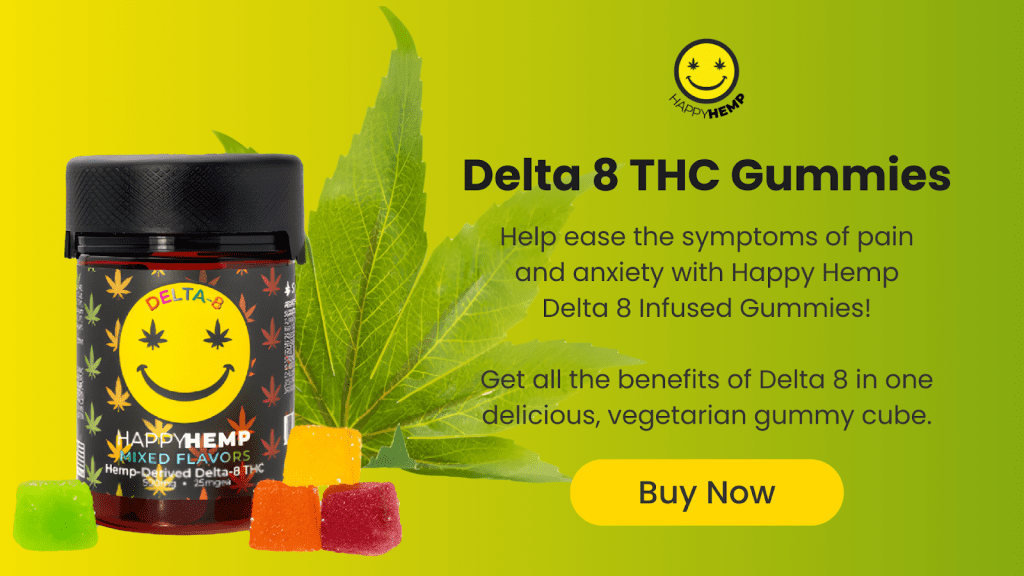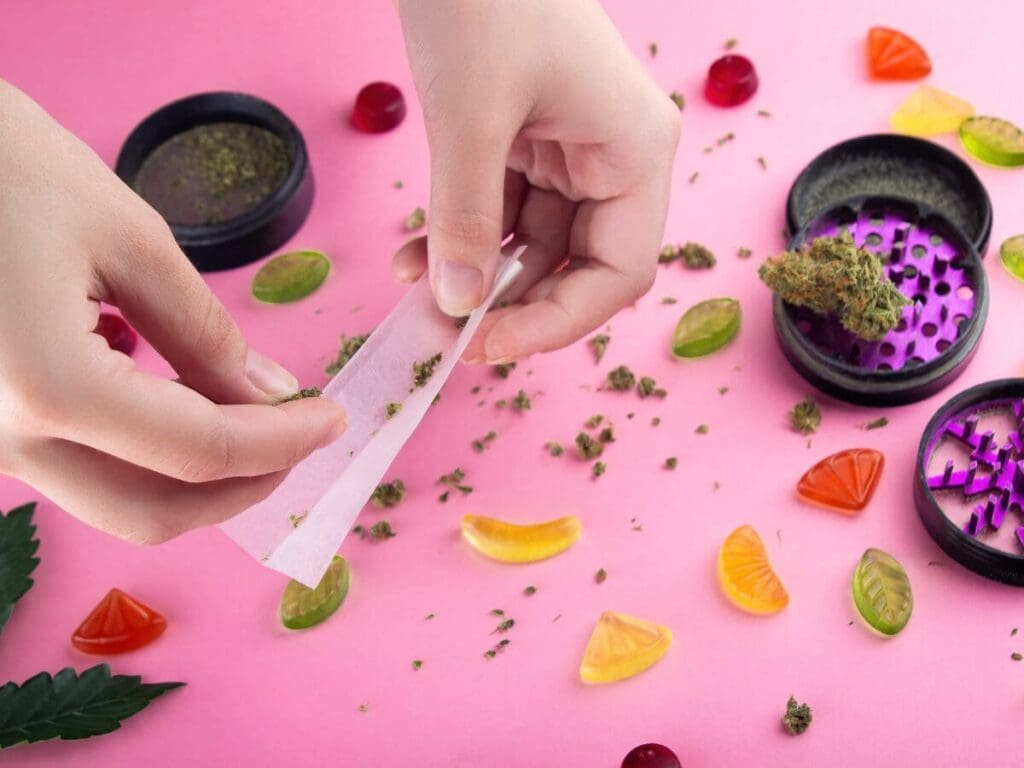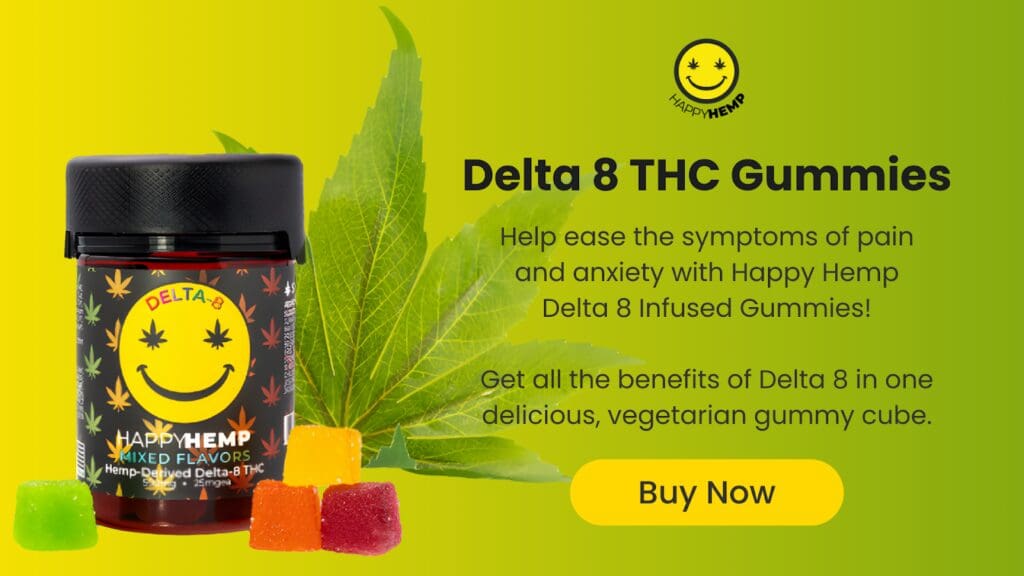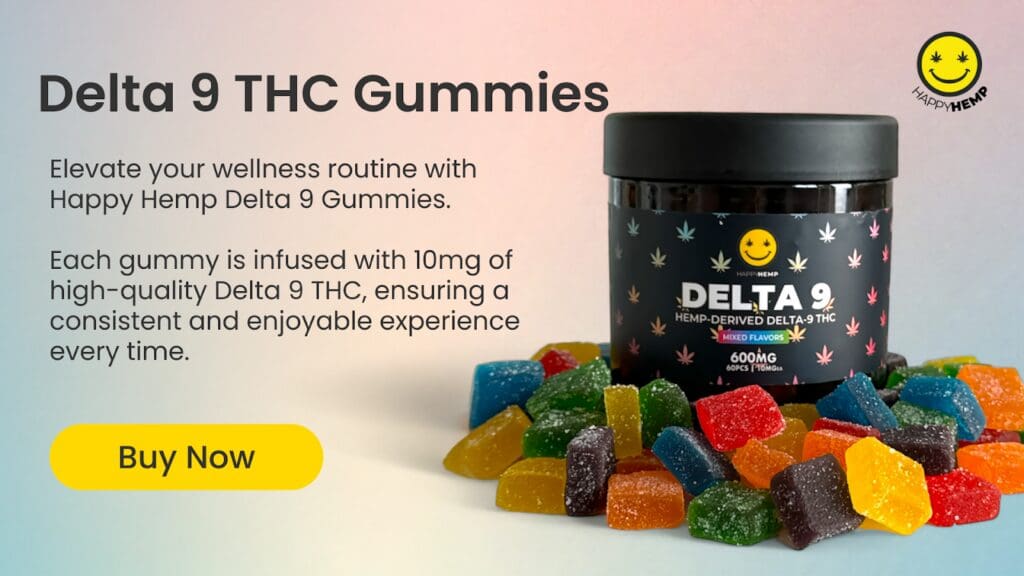Key Takeaways:
- Understanding the Methods: Learn how edibles and smoking deliver cannabis effects differently, catering to unique needs and preferences.
- Weighing the Benefits: Explore the advantages and challenges of each method to make an informed choice that suits your lifestyle.
- Health and Effectiveness: Gain clarity on how edibles and smoking impact your health and effectiveness for different goals.

Finding the right way to enjoy cannabis can feel like choosing between two completely different adventures. The smooth, flavorful allure of edibles offers a discreet, long-lasting experience, while the immediate, classic appeal of smoking delivers instant gratification. Each method brings something unique to the table, but which one aligns with your needs?
At Happy Hemp, we pride ourselves on being a leader in the Delta 8 industry, crafting top-tier gummies and products that elevate the cannabis experience. With a focus on quality and consistency, we aim to help you navigate your cannabis journey with confidence.
This guide will compare the pros and cons of edibles and smoking to help you make an informed decision. Let’s find the perfect fit for your cannabis lifestyle!
What Are Edibles And How Do They Work?
Edibles are cannabis-infused food or drink products, ranging from gummies and chocolates to beverages and baked goods. Unlike smoking, where cannabinoids enter your system through the lungs, edibles are digested and metabolized in the liver before the effects kick in. This creates a different experience altogether.
When you consume edibles, THC is converted into 11-hydroxy-THC, a more potent compound that leads to stronger, longer-lasting effects. However, this process takes time, so it may take anywhere from 30 minutes to 2 hours before you feel the impact. The slow onset can surprise new users, but the prolonged effects often make edibles a favorite for those seeking sustained relief or relaxation.
How Smoking Delivers Its Effects
Smoking cannabis is one of the most traditional and immediate methods of consumption. Whether using a joint, pipe, or vaporizer, the process involves inhaling the smoke or vapor directly into the lungs. This allows cannabinoids like THC to quickly enter the bloodstream through the lungs, reaching the brain within minutes.
The almost-instant effects make smoking an appealing choice for those seeking rapid relief, whether for pain, stress, or other symptoms. However, the high from smoking tends to be shorter in duration compared to edibles, usually lasting 1 to 3 hours. This quick onset and offset can give users more control over their experience, but the method also comes with potential downsides, such as exposure to harmful compounds created by combustion.
Exploring The Pros And Cons Of Edibles
Edibles have emerged as a popular choice for cannabis consumption, offering a unique experience that differs significantly from smoking or vaping. These products range from gummies and chocolates to baked goods and beverages, providing options that cater to diverse preferences. Understanding the benefits and drawbacks of edibles is crucial for making informed decisions about their use.
Long-Lasting Effects Provide Sustained Relief
One of the most appealing aspects of edibles is their extended duration of effects. Unlike inhalation methods, where effects taper off within a couple of hours, edibles can provide relief or relaxation for four to eight hours. This prolonged impact makes them especially suitable for individuals managing chronic pain or seeking an enduring sense of calm.
Discreet Consumption Offers Convenience
Edibles are a highly discreet method of cannabis consumption, as they lack the smoke and odor associated with smoking. This allows users to enjoy cannabis in public or private settings without drawing unwanted attention. From infused beverages to candies, edibles blend seamlessly into everyday life, making them a versatile option.
Precise Dosing Simplifies Intake Management
Many commercially available edibles are pre-dosed and clearly labeled, making it easier for users to control their cannabis intake. This precision is particularly beneficial for beginners or those with specific therapeutic needs, as it minimizes the guesswork involved in determining the right amount to consume.
Smoke-Free Consumption Avoids Lung Irritation
Edibles provide a lung-friendly alternative to traditional smoking methods. Since they are ingested rather than inhaled, they eliminate the risk of lung irritation or respiratory issues caused by smoke. This feature makes them an attractive option for individuals with pre-existing respiratory conditions or those avoiding smoke exposure.
Delayed Onset Challenges Impatient Users
One significant drawback of edibles is the delayed onset of their effects, which can take up to two hours. This waiting period often frustrates users, particularly those expecting immediate relief. The slow activation increases the risk of overconsumption if individuals mistakenly ingest more while waiting for the initial dose to kick in.
Effects Cannot Be Adjusted Once Consumed
Unlike inhalation methods, where users can adjust their intake on the fly, edibles are less forgiving. Once consumed, the effects cannot be reversed or lessened, making it challenging to fine-tune the experience. This rigidity underscores the importance of starting with a low dose to avoid potential discomfort.
Overconsumption Risks Due To Misjudged Dosage
The combination of delayed onset and potent effects makes overconsumption a common pitfall with edibles. Taking an additional dose before the first one takes effect can lead to an overwhelming experience. This risk highlights the need for caution and patience when consuming edibles, especially for newcomers.
Caloric Content May Be A Concern
Edibles, particularly those in the form of sweets or baked goods, often come with added sugars and calories. For individuals mindful of their dietary intake or managing health conditions like diabetes, this added caloric content can be a drawback. Opting for low-calorie or sugar-free alternatives can help address this issue.
Examining The Pros And Cons Of Smoking Cannabis
Smoking remains one of the most traditional and widely recognized methods of cannabis consumption. While it offers immediate effects and a familiar ritualistic experience, it also comes with notable health and environmental considerations. Exploring the advantages and disadvantages of smoking can help users determine whether this method aligns with their needs and lifestyle.
Quick Onset Enables Immediate Adjustment
One of the most significant advantages of smoking is its rapid onset, with effects typically felt within minutes. This immediacy allows users to quickly gauge their reaction and make adjustments by either continuing or pausing consumption. Such real-time control is especially appealing for those seeking fast relief or precise dosage.
Shorter Duration Suits Brief Experiences
The effects of smoking cannabis generally last between one and three hours, making it ideal for users who prefer shorter sessions. This limited duration caters to individuals who need quick relaxation or pain relief without a long-term commitment to the effects. The transient nature of smoking also allows for more flexibility in planning activities afterward.
Ritualistic Appeal Enhances The Social Experience
For many, smoking cannabis holds a cultural or social significance, with traditions such as sharing a joint contributing to the overall experience. The act of rolling, lighting, and passing can foster a sense of camaraderie and connection. This communal aspect makes smoking an integral part of cannabis culture for some users.
Easier Titration Offers Greater Control
Smoking allows for incremental intake, enabling users to stop consuming as soon as they achieve their desired effects. This flexibility reduces the likelihood of overconsumption and offers a level of precision that is challenging to achieve with edibles or other methods. As a result, it is particularly suited for those experimenting with cannabis.
Health Risks Pose Long-Term Concerns
A significant downside of smoking is the introduction of harmful toxins and irritants to the lungs through inhalation. Over time, this exposure can lead to respiratory issues, including coughing, bronchitis, or more severe conditions. Health-conscious users often weigh these risks heavily when considering smoking as a consumption method.
Short-Lived Effects May Require Frequent Use
While the shorter duration of effects is convenient for some, it may not meet the needs of individuals seeking prolonged relief. Those with chronic conditions or high tolerance levels might find themselves needing to smoke multiple times throughout the day. This frequent use can become inconvenient or impractical depending on the setting.
Lingering Odor Can Be A Drawback
The distinct smell of cannabis smoke is easily recognizable and tends to cling to clothing, hair, and surroundings. This can be problematic in environments where discretion is required or where the odor might be unwelcome. For users who prioritize privacy or odor-free consumption, smoking may be less appealing.
Environmental Impact Of Smoking Accessories
The materials used in smoking, such as rolling papers, filters, and lighters, contribute to waste and environmental impact. While seemingly minor, these items add up over time and may be viewed as less eco-friendly compared to other consumption methods. Users concerned with sustainability might consider alternative approaches to reduce their carbon footprint.
Which Method Is More Effective For Different Goals?
The effectiveness of edibles versus smoking largely depends on your individual goals and preferences. Here’s a breakdown:
- For Quick Relief: Smoking is the clear winner here. The near-instant effects make it ideal for situations where immediate relief is needed, such as for acute pain or anxiety.
- For Long-lasting Effects: Edibles excel in providing prolonged relief, making them a better choice for managing chronic conditions like pain, insomnia, or stress.
- For Precise Control: If you need precision and the ability to stop as soon as you’ve had enough, smoking offers more control. On the other hand, edibles can be more reliable for consistent dosing, provided you’re familiar with the product.
- For Discreet Use: Edibles are perfect for those who value subtlety, as there’s no smoke or odor involved. Smoking, while effective, is far less discreet.
- For Social Settings: Smoking often has a communal aspect, making it popular in group settings. Edibles, while discreet, may lack the shared ritualistic experience that smoking offers.
Each method has its place depending on what you’re looking to achieve. Some users even combine methods to enjoy the best of both worlds.
Final Thoughts
Choosing between edibles and smoking ultimately depends on your preferences, health considerations, and desired experience. Edibles are a discreet, smoke-free option with long-lasting effects, making them ideal for managing chronic conditions or enjoying sustained relief. Their gradual onset and precise dosing suit those who prefer a more controlled and prolonged experience. In contrast, smoking offers quick relief, making it perfect for immediate needs or shorter sessions. The ritualistic and social aspects of smoking also appeal to those who value the cultural significance of sharing a joint.
Many users experiment with both methods to determine what works best for their lifestyle. Whether you favor the sustained effects of edibles or the immediacy and sociability of smoking, understanding their unique advantages and drawbacks allows for informed decisions. By considering your health priorities and personal preferences, you can find the method that aligns best with your needs.
Read also:
- Do Delta 8 Edibles Show Up on Drug Tests? Myth or Fact?
- THC Edible Dosage Guide: How Much Should You Take?
- Delta 8 Dosage Guide: How to Find Your Optimal Dose
Frequently Asked Questions About Edibles vs. Smoking
What are the most common reasons people choose edibles over smoking?
People often choose edibles for their discretion, lack of odor, and long-lasting effects, making them ideal for private or extended use.
Why does smoking provide faster effects compared to edibles?
Smoking delivers cannabinoids directly into the bloodstream through the lungs, bypassing the digestion process, leading to almost immediate effects.
Are edibles more cost-effective than smoking?
While edibles may seem pricier upfront, their long-lasting effects can make them more economical for those who use cannabis occasionally.
Can beginners start with edibles, or is smoking better for first-timers?
Beginners can start with edibles, but low doses are crucial to avoid overwhelming effects. Smoking may provide more control for those testing their limits.
Do edibles and smoking differ in terms of THC absorption?
Yes, edibles convert THC into 11-hydroxy-THC, which is more potent, while smoking allows THC to act directly, producing faster but shorter-lived effects.
Is one method safer for people with sensitive lungs?
Edibles are safer for those with respiratory issues or sensitivities, as they don’t involve inhaling smoke or vapor.
How do tolerance levels impact the choice between edibles and smoking?
Regular smokers might have higher tolerance to immediate effects, while edibles may feel more intense due to the stronger metabolized THC.
Which method is better for managing stress or anxiety?
This depends on individual needs. Smoking provides quick, controllable relief, while edibles offer longer-lasting relaxation once the effects set in.
How does flavor play a role in choosing edibles vs. smoking?
Edibles often come in enjoyable flavors, adding a fun and customizable aspect, whereas smoking is more about the natural cannabis taste and aroma.
Can you combine edibles and smoking for a balanced experience?
Yes, combining methods can provide immediate effects from smoking while extending the high with edibles for a tailored experience.
Sources:
- Tashkin, D. P. (2013). Effects of Marijuana Smoking on the Lung. Annals of the American Thoracic Society, 10(3), 239–247. https://doi.org/10.1513/annalsats.201212-127fr
- O’Leary, D. (2002). Effects of Smoking Marijuana on Brain Perfusion and Cognition. Neuropsychopharmacology, 26(6), 802–816. https://doi.org/10.1016/s0893-133x(01)00425-0
- Friese, B., Slater, M. D., & Battle, R. S. (2017). Use of Marijuana Edibles by Adolescents in California. The Journal of Primary Prevention, 38(3), 279–294. https://doi.org/10.1007/s10935-017-0474-7
- Peng, H., & Shahidi, F. (2021). Cannabis and Cannabis Edibles: A Review. Journal of Agricultural and Food Chemistry, 69(6), 1751–1774. https://doi.org/10.1021/acs.jafc.0c07472
- Steigerwald, S., Wong, P. O., Cohen, B. E., Ishida, J. H., Vali, M., Madden, E., & Keyhani, S. (2018). Smoking, Vaping, and Use of Edibles and Other Forms of Marijuana Among U.S. Adults. Annals of Internal Medicine, 169(12), 890. https://doi.org/10.7326/m18-1681









